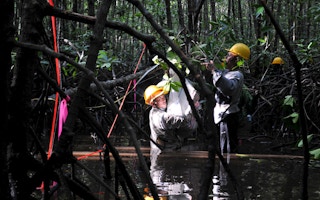Carbon forestry (where local farmers, mainly in developing countries, are paid to remove carbon from the atmosphere by planting and protecting trees) involves two worlds.
On one side, experts sit in front of computer screens using ever more sophisticated analyses and technologies to price and monitor forest carbon. On the other is a very different world – one of sun, dirt, sweat and machetes, where local people work to plant and protect the trees.
Worlds apart
The latter lies at the heart of forest work in rural communities. And the former will not save a single tree without it. But as increasingly bigger projects look to cut costs, how can we ensure that the connection between these two worlds is not lost?
I am a social and environmental researcher at the University of Edinburgh, and over the last three years have had the privilege of adventuring to various developing countries to meet and work with the diverse bunch of people in Plan Vivo’s smallholder carbon agroforestry schemes.
Working first on a research project funded by the Ecosystem Services for Poverty Alleviation (ESPA) programme, and now as a doctoral candidate funded by the UK National Environmental Research Council (NERC) and IIED, I have been researching how local actors fit into global programmes that seek to change local land use.
Plan Vivo’s efforts to connect smallholders and communities to global markets while protecting and providing environmental services is one example of this.
My adventures have immersed me in these two contrasting worlds. I have crunched numbers with experts who monitor and verify carbon, and mingled with investors buying carbon credits. I have hiked over countless hills to see how farmers plant and care for their trees and, at kitchen tables, heard of their arboreal successes and failures.
Three key learnings
During my voyaging, three things have become clear to me.
Firstly, these two worlds are indeed separate − working with very different concepts, and at very different scales: just as farmers know little of statistical generalisations and computer models, technical experts inevitably know little of local quirks in environmental conditions, or unique village customs in managing farm land.
“
No matter how streamlined your processes, no matter how fast or precise your technology, it will never substitute for the good old-fashioned legwork, commitment and expertise of the local people who live near forests.
Secondly, these two worlds need each other. Farmers need technology to provide expertise and analyses to access carbon markets. And the technical world needs the farmers, not just to dig the holes and put trees in the ground, but their expertise to adapt the technical knowledge to the local environmental and social context.
Thirdly, the main (and often sole) connection between these two worlds is through a local, highly-motivated individual in the community: a semi-official central contact, sometimes called a community ‘representative’, ‘coordinator’ or ‘technician’.
They act as translators between the two worlds, solving problems and simply making the whole thing work. They are sometimes (but rarely fully) compensated for their time, so may volunteer out of personal interest, or perhaps other reasons (e.g. to build their standing in the community).
Crucial local connection – at risk?
The Plan Vivo Standard encourages this local connection: a participatory approach provides the bedrock for the entire Plan Vivo methodology. Ultimately all Plan Vivo projects rely on local people to do the organising.
The importance of this local connection is accepted more widely (at least theoretically) in other land use schemes. But, in my view, it is at risk of being crowded out.
Payment for ecosystem service schemes need to grow (or ‘upscale’) significantly if they are to help halt and reverse environmental degradation. A key challenge for smallholder projects is how to upscale and reach more farmers while keeping project administration costs low.

A technical expert in Mexico demonstrates how to analyse forest cover using DigitalGlobe satellite imagery. These technical analyses are important at higher spatial scales, but rely on the work and commitment of local people to be applied on each individual farm (Photo: Geoff Wells)
Increasingly questions arise around whether new technologies can provide a lower cost option than local engagement – whether it pays for a project to redirect funds from local engagement towards new analyses and gadgets (e.g. monitoring with satellites instead of field visits; introducing automated data collection and processing).
I would argue that, while these new technologies can help, sacrificing or diminishing the local connection with farmers could threaten programme success and ultimately lead to less carbon being removed from the atmosphere.
In my view, no matter how streamlined your processes, no matter how fast or precise your technology, it will never substitute for the good old-fashioned legwork, commitment and expertise of the local people who live near forests.
Your view
Looking ahead, my work with Plan Vivo will examine how these local realities can remain central to the fast evolving world of carbon forestry. What do you think?
How important is this local connection to project success? Without it, can the two different worlds communicate? Are there alternative, efficient ways to maintain this connection alongside new technologies? I look forward to hearing from you.
Geoff Wells is a PhD student at University of Edinburgh and a consultant working with IIED’s Sustainable Markets Group. This post was originally published from the IIED blog.











